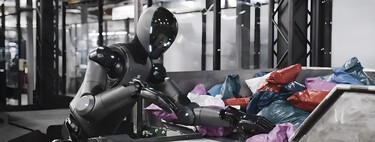When did humanoid robots stop being a spectacle to become a tool? Maybe that’s right there. Sources consulted by Reuters say that NVIDIA and FOXCONN are in conversations to display them in a server manufacturing plant of artificial intelligence in Houston.
Nvidia has trusted the Taiwanese giant to lift a new server manufacturing plant in Houston, Texas. The objective: produce the GB300, their new AI servers based on the Blackwell architecture, within the ambitious plan to relocate part of its production in US territory.
As Reuters has advanced, both companies are in conversations to display humanoid robots in this factory. The intention would be that they begin to operate in the First quarter of 2026. If concrete, it will mark a double milestone: it would be the first time that a NVIDIA product is manufactured with the help of these tools, and also the first use of this technology by Foxconn in a production line of AI servers.
Houston is not any factory: something new is prepared here
For now, the details are scarce. It is not known how many robots will be used, how will they look or what exact functions they will perform. But there are indications. In an internal presentation of May, Foxconn showed how he was training humanoid robots for tasks such as manipulating objects, inserting cables or making basic assemblies, usual activities in the manufacture of servers.
Houston’s choice is not accidental. Being a new plant, spaces are being designed with margin to integrate these technologies From the beginningsomething much more complex to achieve in already operational facilities. According to one of the sources consulted, that design would facilitate the incorporation of humanoid robots in the line.

NVIDIA GB300 has a rack scale design
That Nvidia bet on humanoid robots in its production chain is not just a logistics movement. It is also a declaration of intentions. Until now, no company product had been manufactured with the help of this type of robots. And Foxconn, the largest manufacturer on the commission of the world, had not used them in a production line dedicated to AI servers.
The decision, according to what the sources have told Reuters, would mark the beginning of a new stage for both companies. In the case of Foxconn, it would also serve to show the world the advances in robotics who has been developing with Nvidia, although third -party models such as those of China Ubtech have also been tested.
For Nvidia, the movement fits with its broader strategy. The company not only designs chips for AI models training: it also offers a specific development platform for humanoid robots, with visual, motor and cognitive abilities based on its own architectures. In March, Jensen Huang himself predicted that the general use of humanoid robots in industrial environments would arrive “in less than five years.”
They are not alone: Tesla, Mercedes, BMW, China
The idea of incorporating humanoid robots into the assembly lines is no longer a rarity. Although its deployment is still limited and experimental, several manufacturers have been testing this technology for some time in controlled environments or in very specific tasks. Among them, BMW stands out, which has rehearsed in US plants. And it is known that Tesla, who has developed his own humanoid robot called Optimus, has put at least two units in a production line.
But interest is not limited to the great western brands. China has converted humanoid robotics into a national strategic priority within its Made in China 2025 plan. Companies like Ubtech – whose model has also been evaluated by Foxconn – are being driven directly by the government with a view to transforming the industrial fabric of the country. This mission is part of strategic alliances such as Huawei and Ubtech completed this year.
This possible deployment of humanoid robots in Houston does not occur in a vacuum. Is part of a broader movement, driven by political pressure and the strategic need of Relocate production Technological on American soil. In April, Nvidia announced its intention to make infrastructure of AI worth up to 500,000 million dollars in the US in the next four years, with partners such as TSMC, Wistron and Foxconn itself.
For many companies, automating is a matter of survival.
The Houston factory, still under construction, is part of that strategy. But producing locally implies facing at least one new problem: the shortage of labor. And that is where automation would come into play. Perhaps not essentially for these factories, but as a test field for possible future expansions.
For many companies, automating is no longer a matter of improvement. It is a matter of survival. Thus, more and more local actors are developing humanoid robots designed specifically for the industry. Tesla, Figure, Apptronik o Agility Robotics They are among the companies that have opted for this new generation of machines.

Jeff Burnstein, president of the Association for Advancing Automation, summed up the new industrial reality to Axios: “This is how it competes today”, so “you have to take advantage of the best available tools.”
Humanoid robots lived for years with skepticism: beautiful exhibitions, Little useful in practice. Now, that perception is turning. We are faced with a change that aims to be important, but whose real range we will know only over time.
Images | Nvidia | Boliviainteligent
In WorldOfSoftware | The US is willing to do anything for advanced chips not to reach China. And Malaysia is an obstacle











